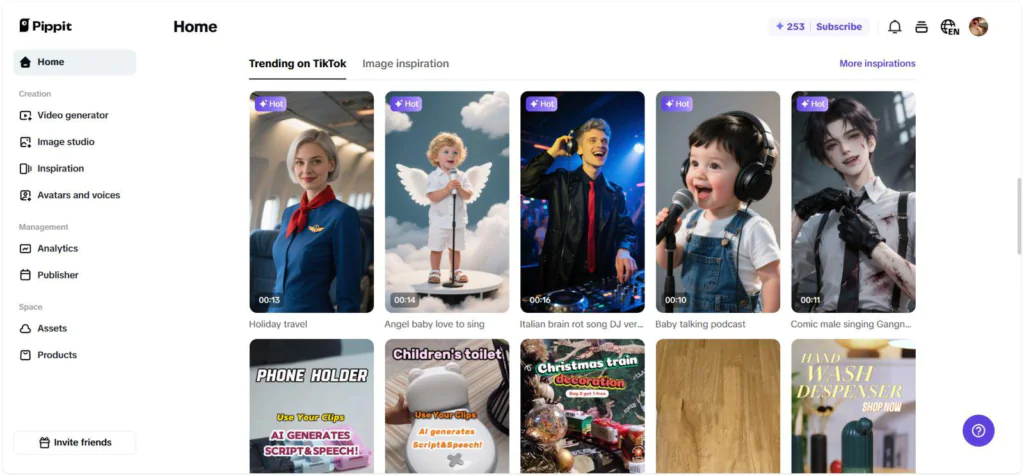When we consider video captions, we tend to envision words on screen that interpret spoken words. However, captions can also depict what is not being expressed: the clinking of coffee mugs, a burst of laughter from the crowd, or the off-screen rumble of thunder. Oddly enough, these small details can increase your online visibility. Search engines cannot “hear” sound, but they can index the words you use to describe them.
With sites like Pippit, and software like its AI video generator, creators can now add captions to both dialogue and background noises in a snap. This doesn’t only make videos more accessible, it opens up a brand-new window of search engine optimization.
Why silent details can be loud online
Today’s internet is noisy, both literally and figuratively. But lots of people watch videos on mute when they’re on their way to work, multitasking, or sitting in public areas. For them, captions aren’t a nicety; they’re a necessity. When you add descriptive captions such as waves crashing or applause fades, you provide context to silent viewers and keep them engaged.
Background captions as SEO optimizers
Including captions for non-speech audio introduces three obvious benefits:
- Additional metadata: Algorithms get to read more words, making your content more discoverable.
- Improved engagement: When audiences know what’s occurring off-camera, they stay tuned for longer.
- Universal design: Accessibility isn’t only good for deaf audiences, it benefits all of them.
Together, these elements signal worth to platforms, driving your content upwards in search.
Where descriptive captions shine
- Food and travel blogs: “Pan sizzling” or “birds chirping” adds flavor.
- Comedy sketches: crowd laughter assists in delivering the punchline.
- ASMR videos: Sounds are the whole content, and captions make them accessible.
Sound as a branding tool
Consider jingles, product sounds, or distinctive effects that are associated with your brand. If you label those consistently, branded chimes or signature pour sound, they are part of your searchability. Eventually, fans may even search those words into search bars, tracing them back to you.
Captions are more than accessibility; they are a means of planting brand associations in text.
The power of a video translator
Adding subtitles is one thing. Translating subtitles across languages is another. A strong video translator doesn’t merely replace dialogue; it also translates ambient subtitles. That is, your crowd cheering in English can be translated to ovación del público in Spanish or applaudissements du public in French.
For international creators, this makes the mood and setting consistent regardless of the audience. Silence is universal, but translating it keeps your narrative continuous globally.
Three fun steps: translating videos with Pippit
Here’s how you can record and share background sound captions with Pippit:
Step 1: Open video generator and quick cut
Sign into your workspace and go to your Video Generator. While here, select Quick Cut from the left-hand menu to access your editing studio, this is where all of your multilingual magic begins.
Step 2: Upload your video, then auto-caption and translate
Upload your video file and let Pippit do the rest. Click Auto Captions to create captions automatically, including any background noise Pippit captures, then immediately click Translate to translate the captions into the target language.
Step 3: Text-to-speech, audio cleanup and export
Select Text to Speech and apply it to all so all of your translations have a voice, then isolate your original audio and remove it so you have no audio overlap.
Once your new multilingual version is prepared, click Export to download or share.
When silence is mightier than the dialogue
For certain types of content, background captions are more significant than dialogue lines. Consider ASMR, nature documentaries, or factory behind-the-scenes tours. The sound of a machine humming, leaves rustling, or birds chirping takes center stage. Recording and describing those sounds enables you to rank in search terms you may never have thought of.
Technology that makes it easy
A notable innovation is lip sync AI of Pippit, originally created for dubbed dialogue. The identical timing precision that synchronizes voices with lip movements also ensures that background captions are always perfectly synchronized with the video’s rhythm. It makes sure that when the thunder claps, your thunder rumbling caption shows up at the appropriate moment.
Ideal practices for recording silent details
- Be specific: dog barking is indefinite; puppy whining softly is descriptive.
- Keep it concise: Don’t clobber the screen with words.
- Stay consistent: Use consistent words for recurring brand sounds.
Both viewer experience and search relevance are improved with these practices.
Accessibility meets opportunity
Descriptive captions were initially considered only accessibility features. Today, they’re growth levers. By making your videos more accessible for people with hearing loss, non-native speakers, or anyone watching on mute, you open up more avenues for engagement. Every new audience segment means another opportunity to grow.
The future: the SEO of atmosphere
The future of video SEO is not all about transcription of dialogue. The platforms are shifting towards recognizing the overall mood of content. Content creators who begin captioning their ambient sounds now are setting themselves up for long-term relevance.
In the coming tide of international storytelling, silence will not go unnoticed; it will be the text that says a lot.
Conclusion: let silence be heard
Background sound captions are more than accessibility features. They’re a secret SEO tactic. By transcribing the quiet bits, you make your content more understandable for algorithms and keep your viewers engaged.
With Pippit, creators and brands can easily add, translate and share captions that cover everything from dialogue to atmosphere. If you want your content to rise above the noise, start translating silence today, Pippit makes it simple, effective and global.








